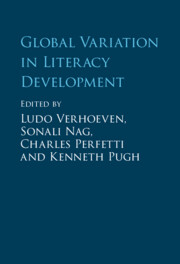Book contents
- Global Variation in Literacy Development
- Global Variation in Literacy Development
- Copyright page
- Contents
- Figures
- Tables
- Contributors
- Abbreviations
- 1 Introduction
- Part I Regional Variations
- 2 Sociocultural Variation in Literacy Development in Canada and the United States
- 3 Literacy Contexts and Literacy Development in South America
- 4 Postcolonial Literacy Development in the Caribbean
- 5 Literacy Development in Europe
- 6 Literacy Education and Development in Russia
- 7 Literacy Development and Language of Instruction in Sub-Saharan Africa
- 8 Literacy and Linguistic Diversity in Multilingual India
- 9 Literacy Development in East Asia
- 10 Literacy and Linguistic Diversity in Australia
- Part II Neurobiological and Ecological Markers
- Index
- References
8 - Literacy and Linguistic Diversity in Multilingual India
from Part I - Regional Variations
Published online by Cambridge University Press: 23 November 2023
- Global Variation in Literacy Development
- Global Variation in Literacy Development
- Copyright page
- Contents
- Figures
- Tables
- Contributors
- Abbreviations
- 1 Introduction
- Part I Regional Variations
- 2 Sociocultural Variation in Literacy Development in Canada and the United States
- 3 Literacy Contexts and Literacy Development in South America
- 4 Postcolonial Literacy Development in the Caribbean
- 5 Literacy Development in Europe
- 6 Literacy Education and Development in Russia
- 7 Literacy Development and Language of Instruction in Sub-Saharan Africa
- 8 Literacy and Linguistic Diversity in Multilingual India
- 9 Literacy Development in East Asia
- 10 Literacy and Linguistic Diversity in Australia
- Part II Neurobiological and Ecological Markers
- Index
- References
Summary
This chapter focuses on literacy and linguistic diversity in India as the second most populous nation in the world. India is home to different types of writing systems and linguistic situations; however, literacy acquisition in the region is often defined using alphasyllabic akshara orthographies and multilingualism. Both these characteristics have significant implications for the theory, practice, and policy of literacy acquisition in India. In India, only 44 percent of students in government schools can read Grade-2-level texts in Grade 5 fluently. Within India, there is, however, wide variation, with literacy rates being significantly higher in private schools and in urban areas. We begin with a brief description of the historical and contemporary state of multilingual education policy and practice in India. In addition, the psycholinguistic underpinnings of learning to read in akshara orthographies and of biliteracy acquisition with at least one akshara orthography will be uncovered. Finally, future directions related to literacy development research and practice among diverse populations in India are discussed.
- Type
- Chapter
- Information
- Global Variation in Literacy Development , pp. 155 - 173Publisher: Cambridge University PressPrint publication year: 2023
References
- 1
- Cited by

